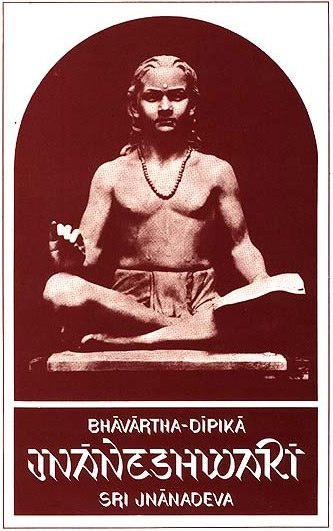Jnaneshwari (Bhavartha Dipika)
by Ramchandra Keshav Bhagwat | 1954 | 284,137 words | ISBN-10: 8185208123 | ISBN-13: 9788185208121
This is verse 5.24-25 of the Jnaneshwari (Bhavartha-Dipika), the English translation of 13th-century Marathi commentary on the Bhagavad-Gita.—The Dnyaneshwari (Jnaneshwari) brings to light the deeper meaning of the Gita which represents the essence of the Vedic Religion. This is verse 24-25 of the chapter called Sannyasa-yoga.
Verse 5.24-25
Verse 5.24: “He whose bliss is in himself; whose solace is in himself; and likewise who is an inner light unto himself: such a Yogin—realising his oneness of essence with Brahman—attains extinguishment in Brahman.
Verse 5.25: “(Such) extinguishment in Brahman do the sages attain whose (liability to) defilement is at an end; who have cut asunder (all sense of) duality; and who, with disciplined selves, are intent upon securing the weal of all beings. (136)
Commentary called Jnaneshwari by Jnaneshwar:
Therefore, I say unto you, that this is indeed a vision unspeakable and truth that is unutterable. One that has experienced the being of Self, will be able to understand all through this intimation and suggestion. Those that have got intoxicated with this happiness of the Self and are absorbed in the Self—I take them all to be beings whose souls are cast in essence in the very unitary Being of the Supreme Brahman: they are the very embodied manifestation of joy, and in them is the blossom of happiness, and the dwelling or abode of the realisation of the Self. They should be taken to be the very (birth-), place of true vision, the very form itself of the essence of the Supreme Brahman, or the decorated organs of the Brahman lore. They should be known as the very essence that lives in the righteous or the very life of sentience itself.
The hearers, at this stage of the fullness of the sermon, intervened and said,
“Enough of this. In how many colours you are going to paint one and the same idea? You get enamoured of the praises of the saints and lose the thread of the narrative, and you feel a prompting to use elegant and flowery phraseology in propounding the qualityless (nirguṇa) theme (of Brahman). Curb the flow of this prompting and brighten the lamp of the Gita-teaching and create an auspicious dawn in the temple of the saints’ hearts!”
At this command of his master, the disciple of Nivrittinatha said to his hearers, “Hear what Lord Krishna said,
“Oh Arjuna, those that have once reached the bottom of the unfathomable depth of the whole of the river in the form of the bliss of the Self, become steady there and get merged into it; or one who sees within himself with pure light of the knowledge of Self, the entire Universe, there is no objection to call such a one the embodied form of the Supreme Brahman. Those that are desireless only become qualified for this Vatan [Vatana] (hereditary birth-right) in the form of the Supreme Brahman, which is all real, the best of all, indestructible and limitless. This is reserved only for the great sages and comes to the share of the ascetics, its growth being doubtless perpetual.
